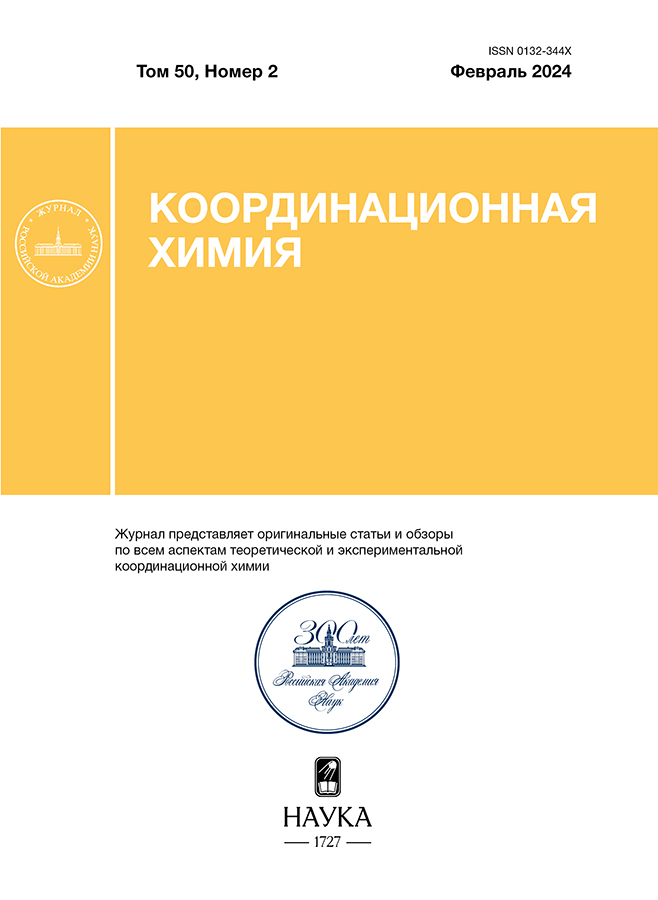Stereochemistry of the cis-Tetrafluoro Complexes of Titanium with 1-Ac-2-[Ph2P(O)]-Cyclohexane (1RS,2SR) Stereoisomers in СН2Сl2
- Authors: Il’in E.G.1, Parshakov A.S.1, Privalov V.I.1, Churakov A.V.1, Bodrin G.V.2, Goryunov E.I.2
-
Affiliations:
- Kurnakov Institute of General and Inorganic Chemistry, Russian Academy of Sciences
- Nesmeyanov Institute of Organoelement Compounds, Russian Academy of Sciences
- Issue: Vol 50, No 2 (2024)
- Pages: 92-99
- Section: Articles
- URL: https://rjonco.com/0132-344X/article/view/667617
- DOI: https://doi.org/10.31857/S0132344X24020032
- EDN: https://elibrary.ru/OSCMYY
- ID: 667617
Cite item
Abstract
The monodentate phosphoryl-containing ligand 1-Ac-2-[Ph2P(O)]-cyclohexane (L) bearing two asymmetric carbon atoms is synthesized. The study of its crystal structure shows that L is a racemic mixture of (1R,2S) and (1S,2R) stereoisomers. The complex formation of L with TiF4 in СН2Сl2 is studied by 19F{1Н} and 31Р{1Н} NMR spectroscopy. The compositions of the complexes formed in the solution are determined. Racemic and meso-diastereomers of the octahedral complex cis-TiF4L2 are formed in the solution as found by an analysis of the 19F and 31Р NMR spectra taking into account the concept of heterotropy of organic compounds. The influence of the optical configuration of stereoisomers of the monodentate ligand coexisting in the coordination sphere of the [MF4L2] octahedral tetrafluoro complexes of transition d0 metals on the chemical shifts of the fluorine atoms arranged in the trans positions relative to each other is shown. In the meso-diastereomer of cis-TiF4L2, this results in a nonequivalence of the fluorine atoms on the F–Ti–F' ordinate of the octahedron, and the spin-spin coupling constant JFF' = 286.1 Hz is observed in the 19F{1H} NMR spectrum.
Keywords
Full Text
About the authors
E. G. Il’in
Kurnakov Institute of General and Inorganic Chemistry, Russian Academy of Sciences
Author for correspondence.
Email: eg_ilin@mail.ru
Russian Federation, Moscow
A. S. Parshakov
Kurnakov Institute of General and Inorganic Chemistry, Russian Academy of Sciences
Email: eg_ilin@mail.ru
Russian Federation, Moscow
V. I. Privalov
Kurnakov Institute of General and Inorganic Chemistry, Russian Academy of Sciences
Email: eg_ilin@mail.ru
Russian Federation, Moscow
A. V. Churakov
Kurnakov Institute of General and Inorganic Chemistry, Russian Academy of Sciences
Email: eg_ilin@mail.ru
Russian Federation, Moscow
G. V. Bodrin
Nesmeyanov Institute of Organoelement Compounds, Russian Academy of Sciences
Email: eg_ilin@mail.ru
Russian Federation, Moscow
E. I. Goryunov
Nesmeyanov Institute of Organoelement Compounds, Russian Academy of Sciences
Email: eg_ilin@mail.ru
Russian Federation, Moscow
References
- Safiulina A. M., Matveeva A. G., Evtushenko A. V. et al. // Russ. J. Gen. Chem. 2015. V. 85. № 9. P. 2128.
- Goryunov E. I., Bodrin G. V., Goryunova I. B. et al. // Russ. Chem. Bull. 2013. № 3. P. 779.
- Il’in E. G., Parshakov A. S., Yarzhemskii V. G. et al. // Dokl. Ross. Akad. Nauk. 2015. V. 465. № 3. P. 314.
- Il’in E. G., Parshakov A. S., Danilov V. V. et al. // Dokl. Ross. Akad. Nauk. 2016. V. 471. № 2. P. 163.
- Il’in E. G., Parshakov A. S., Danilov V. V. et al. // Russ. J. Coord. Chem. 2018. V. 44. P. 619. https://doi.org/10.1134/S1070328418100068
- Il’in E. G., Parshakov A. S., Privalov V. I. et al. // Dokl. Ross. Akad. Nauk. 2016. V. 467. № 5. P. 547.
- Il’in E. G., Parshakov A. S., Aleksandrov G. G. et al. // Dokl. Ross. Akad. Nauk. 2016. V. 470. № 2. P. 176.
- Il’in E. G., Kovalev V. V., and Nifant’ev E. E. // Dokl. Ross. Akad. Nauk. 2018. V. 479. № 3. P. 283.
- Il’in E. G., Parshakov A. S., Danilov V. V. et al. // Russ. J. Coord. Chem. 2019. V. 45. P. 340. https://doi.org/10.1134/S1070328419030035
- Parshakov A. S., Privalov V. I. et al. // Russ. J. Coord. Chem. 2019. V. 45. P. 667. https://doi.org/10.1134/S1070328419090057
- Krause L., Herbst-Irmer R., Sheldrick G. M., and Stalke D. J. // Appl. Crystallogr. 2015. V. 48. № 1. P. 3. https://doi.org/10.1107/S1600576714022985
- Sheldrick G. M. // Acta Crystallogr., Sect. C: Struct. Chem. 2015. V. 71. № 1. P. 3. https://doi.org/10.1107/S2053229614024218
- Groom C. R., Bruno I. J., Lightfoot M. P., and Ward S. C. // Acta Crystallogr., Sect. B: Struct. Sci., Cryst. Eng. Mater. 2016. V. 72. P. 171. https://doi.org/10.1107/S2052520616003954.14
- Buslaev Yu.A, and Ilyin E. G. // J. Fluorine Chem. 1984. V. 25. № 1. P. 57.
- Potapov V. M. Stereokhimiya (Stereochemistry). Moscow: Khimiya, 1988.
- Gaudemer A., Minkin V. I., and Jacques J. // Stereochemistry Fundamental and Methods. V. 1. Kagan H. B., Ed. Stuttgart, 1977. P. 73.
- Eliel E. L., Wilen S. H., and Doile M. P. Basic Organic Stereochemistry. New York: Wiley, 2001.
- Mislow K, and Raban M. Topics in Stereochemistry // Allinger N. L., and Eliel E. L., Eds. New York: Wiley-Interscience, 1967. V. 1.
Supplementary files


















